Foot Soldiers in the War on Ebola
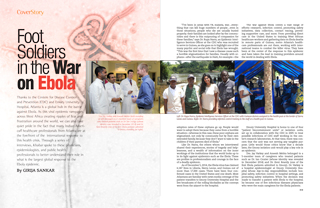
Thanks to the Centers for Disease Control and Prevention (CDC) and Emory University Hospital, Atlanta is a global hub in the battle against Ebola. As this viral epidemic rampages across West Africa creating ripples of fear and frustration around the world, we can also take quiet pride in the fact that many Indian American healthcare professionals from Atlanta are at the forefront of the international response to this health crisis. Khabar spoke to these physicians, epidemiologists, and public health professionals to better understand their role in what is the largest global response to the Ebola epidemic.
“I’ve been in areas with TB, malaria, war…everything that can kill huge numbers of people…even in those situations, people who die are usually buried properly; their families are looked after by the communities and there is this outpouring of compassion for these families,” says Dr. Rupa Narra, an Epidemic Intelligence Services Officer at the CDC who was recruited to serve in Guinea, as she goes on to highlight one of the many psychic and social tolls that Ebola has wrought. “This was the first time that I saw a disease cause such a horrible stigmatization for families. Usually with orphans—after the earthquake in Haiti, for example—the adoption rates of these orphans go up. People would want to adopt them because they came from a horrible situation—whereas in this case, these poor orphans are stigmatized, not only by community but by their own extended family, because they don’t want to take in the children if their parents died of Ebola.”
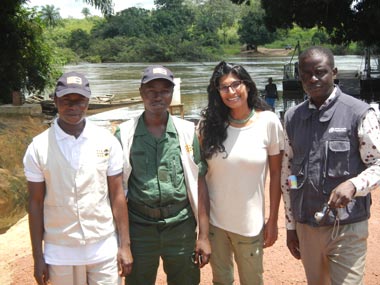
Dr. Rupa Narra, Epidemic Intelligence Services Officer at the CDC with Guinean doctors assigned to the health post at the border of Sierra Leone and Guinea.
Like Dr. Narra, the others whom we interviewed shared their experiences, stories of tragedy and helplessness, and a wealth of information on the inner workings of the institutions that the world looks up to in its fight against epidemics such as the Ebola. These are profiles in professionalism and courage in the face of a deadly epidemic.
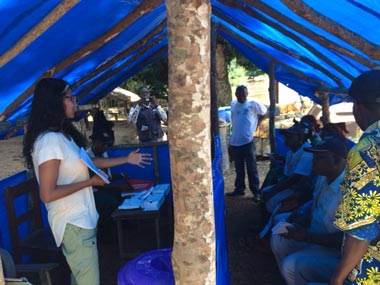
Dr. Narra (left) providing infection control training to the staff at a health post in Guinea.
As of December 5, 2014, the Ebola virus has claimed 6,187 lives in Liberia, Sierra Leone, and Guinea out of more than 17,000 cases. There have been four confirmed cases in the United States and one death. Most Atlantans are familiar with news media coverage of the patient transfers to Emory University Hospital and the live broadcasts of the rolling blockades as the convoys went from the airport to the hospital.
The war against Ebola covers a vast range of efforts—research, infection control, promoting safety initiatives, data collection, contact tracing, providing supportive care, and more. From providing direct care in the United States to training West African healthcare workers and gathering data on Ebola deaths in remote parts of Guinea, metro Atlanta’s healthcare professionals are out there, working with international teams to combat the killer virus. They have been at the center of the response to this epidemic and have taken the lead in training providers around the world in dealing with Ebola.
Emory University Hospital is home to one of four “patient biocontainment units” or isolation units, set up in collaboration with the CDC in 2005 to treat possible infections of CDC staff working in the center’s research laboratories. At that time, there was concern that the unit was not serving any tangible purpose. Little would those critics know that a decade later, the Emory isolation unit would play a key role in an epidemic.
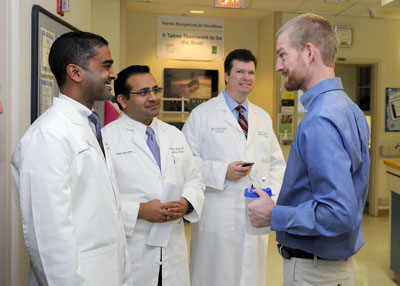
Drs. Jay Varkey and Aneesh Mehta (both standing on left) belonged to a 5-member team of caregivers who treated patients such as Dr. Ian Crozier (whose identity was revealed in December 2014) and Dr. Kent Brantly (one of the first Ebola patients admitted to Emory, standing far right).
Dr. Varkey is a hospital epidemiologist at Emory University Hospital whose day-to-day responsibilities include hospital safety, infection control in hospital settings, and promoting safety initiatives. When the decision was made to transfer a patient with Ebola to the hospital, he became one of five infectious diseases physicians who were the main caregivers for the Ebola patients.
Dr. Aneesh Mehta, Assistant Professor of Medicine, Infectious Diseases at Emory University, has been a member of the communicable diseases unit at Emory University Hospital for close to six years and was the physician on call when Emory received their first patient, making him the admitting physician for the first patient.
Elaborating further, Dr. Mehta says, “We have the good fortune of living and working in Atlanta, a hub for national and global health; we [the Emory team] have worked with the CDC, in domestic and international response and also in research response. We have been able to provide real-time research questions to CDC scientists on Ebola. We have also worked with the Carter Center with the coordination of resources going to West Africa.” Dr. Varkey adds, “The CDC has taken the lead in working with other hospitals around the country and is conducting site visits, while our hospital has offered up our services to share what we have learned from treating the patients with Ebola.”
In line with its initiative to set up regional centers for excellence, the CDC recently designated 35 hospitals, including Emory University Hospital, as Ebola treatment centers in the United States. Of the 10 Ebola patients treated in the US to date, four received care at Emory. With the experience that the Serious Communicable Disease team has gained over the summer and fall of 2014, there is a heightened need to share their knowledge and insights, says Dr. Varkey. “One of the challenges was that we received queries from not just around the country but around the world about what we did. To try and meet the needs, we published a standard operating protocol—our entire playbook if you will—with all 84 pages of it online that is available for any person who seeks to learn more about what we did at Emory.” An invaluable resource indeed for hospitals and health care providers, especially in developed countries, preparing to treat possible Ebola cases.
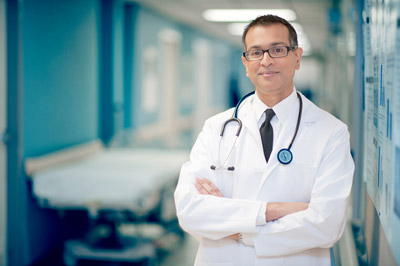
Dr. Arjun Srinivasan, Assoc. Director, Healthcare Associated Infection Control Programs, Division of Healthcare Quality Promotion, CDC.
Dr. Arjun Srinivasan has been involved with CDC’s response to the epidemic since August 2014. “As a subject matter expert, the CDC has been responding to Ebola outbreaks for decades and CDC epidemiologists have been visiting outbreak areas in Africa many times over the years,” says Dr. Srinivasan. Traditionally focused on US-based infection control in healthcare settings, his division at the CDC began working on infection control in international settings when the outbreak occurred in West Africa.
Lessons learned
Across divisions, healthcare professionals are virtually united in emphasizing the importance of education. Commenting on safety in healthcare settings, Dr. Srinivasan says, “I think one of the key lessons is preparation and education in infection control. There
is a heightened need for it, both for Ebola and other
infections; the work we’re doing to provide infection control standards and improvements will benefit
Ebola but also prevent other infections.”
At Emory University, the challenge was to provide sustained “supportive care” which, studies suggest, may contribute to better survival. This includes providing oral rehydration, intravenous fluids, treating other infections as they occur, and maintaining blood pressure. Dr. Mehta credits the Emory team’s success to advance preparation in supportive care: “We put together a command team that included hospital leadership, nurse leadership, engineers, doctors, environmental specialists…we put all the parameters out there. When we were preparing for the first patient, we were in fact preparing the second, third, and fourth patient as well.” Dr. Varkey, who was Dr. Mehta’s fellow team member, responds in a similar vein: “I think for me, the key takeaway is having a tight cohesive team that believes in the mission at hand and doesn’t just practice or train but also demonstrates competency. In other words, this is hard work and really requires a whole hospital effort to do it correctly. And I think, having the right team, having them practice and be motivated but also have them be certified as competent was really important.” He adds, “One thing with working long hours with critically ill patients was the knowledge that I wasn’t alone…at any given point of time, I had at least two nurses watching my back and watching my colleagues’ back and maintaining a safe environment.”
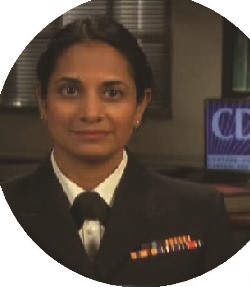
Dr. Agam Rao, a medical officer in the Division of Foodborne, Waterborne and Environmental Diseases at the CDC.
What it’s like working in the epicenter
Today, the CDC has 175 staff deployed on the ground in West Africa providing a variety of services including disease surveillance, data collection, contact tracing, and assessments. Dr. Agam Rao, a medical
officer in the Division of Foodborne, Waterborne and
Environmental Diseases at the CDC, was part of the
second team that was deployed to Liberia in August
2014. While there, she participated in a number of different tasks. Says Dr. Rao, “We were trying to assess the needs on the
ground, work with the
Ministry of Health and
some of the other partners
that were in the field at the
time to try to address all of the
needs. I am trained in infectious
diseases, and so I was in some of the hospitals in the
capital of Monrovia and other hospitals in Montserrado
County trying to assess needs related to everything
from PPE [Personal Protective Equipment] to infection
control. I was helping coordinate logistics for
laboratory data flow. We all had multiple tasks. The
needs were changing on a daily basis, so we were
shifting our focus depending on the needs.”
Dr. Rupa Narra, the Epidemic Intelligence Services Officer at the CDC, says, “August 5, 2014 was when the WHO announced that there was a public health emergency. On August 5, I was deployed to Guinea. I was a French speaker and had done some work in developing countries with Doctors Without Borders as well.”
While in Guinea, Dr. Narra initially helped with data collection and management. “We would be given information from different Ebola Treatment Units and we would enter the data into the computer information system, to collaborate with Doctors Without Borders (Médecins Sans Frontières, MSF), the Ministry of Health and the World Health Organization (WHO). I spent 10 days in Conakry, the capital of Guinea. Afterwards we realized that there was a big need in Guéckédou, a forested region in the southeast. I spent three weeks there and helped with contact tracing in the region. The last ten days, I got to work directly with an MSF nurse who was local to the region and we visited the local health care centers, teaching infection control and identifying Ebola cases,” adds Dr. Narra.
Back home, others like Dr. Snigdha Vallabhaneni worked in the CDC’s Emergency Operations Center as part of the International Infection Control Team for a month. Dr. Vallabhaneni helped design a training program for West African healthcare workers focusing on infection control practices. “Knowledge of infection control practices and strict practice of these principles at all times is the key to keeping healthcare workers and patients from contracting Ebola.” In January 2015, Dr. Vallabhaneni will be deployed to Sierra Leone, which has the highest number of Ebola cases in West Africa “to help train health care workers in the country on infection control practices and assess health care facilities on their Ebola preparedness.”
Communication and other challenges
For healthcare professionals operating within the
US, disseminating appropriate information and allaying
public fears about Ebola is an important responsibility
and challenge. As Dr. Varkey remarks, “It’s always
a delicate balance between recognizing what is a rational
human reaction to being concerned about something
that is new and unknown versus feeding into
something that’s borderline hysteria. The fact of the
matter is, as long as there is an outbreak in West Africa,
we have to prepare for the eventuality that there are
persons who are going to arrive in this country that are
sick, and when that happens we need to be ready to respond
and not engage in this public primal scream. We
have to be ready. Emory has demonstrated this, and so
has the University of Nebraska and Bellevue Hospital in
New York.” As Dr. Narra puts it, “Fear of the unknown is
normal and is expected. The important thing is to keep
the messaging consistent and correct.”
One interesting concern from the general public came to the Emory team in the form of a lengthy email about disposing of hospital waste into the sewer system. Dr. Mehta says, “The concern was that if we were to flush Ebola infected waste down the toilet, then all the sewer rats would get Ebola and start attacking people!” But, of course, hospital protocols require that any bodily fluids and waste from Ebola patients be treated with bleach or other disinfectants and allowed to sit for a while before disposal.
For those deployed in the field, challenges took on a distinctly and disturbingly human face. Dr. Rao says, “What was striking was that the Ebola treatment units were full; the needs far surpassed the number of the units in the country [Liberia]…. there were people that had to be turned away from the treatment centers. This one particular time, a family with a young child was turned away, only to return an hour later with the child who had passed away while in transit.” As physicians, she adds, “We are used to seeing patients die but not at this volume and not without palliative care and humane treatment in the final stages.”
Looking out for the caregivers—who has their back?
Another serious and distinctive challenge that
Ebola presents is the risk to healthcare providers. Says
Dr. Vallabhaneni, “I think the most difficult thing with
this disease, because of its high transmissibility in the
absence of strict infection control practices, is how
many healthcare workers have fallen ill and died of
Ebola during this epidemic. These countries already
have healthcare provider scarcities—and losing healthcare
workers to the disease they are battling on the
frontlines makes it very hard for these healthcare
systems to continue treating patients effectively
and eventually stop the epidemic. Without keeping
healthcare workers safe, we will not be able to control this epidemic. That is why I was so motivated to join the infection control team.”
How did Emory and CDC medical professionals cope in their personal lives as they took on high-risk operations?
WHO assessments from October 2014 suggest that the fatality rates among healthcare providers in West Africa may have been as high as 57%. Of the four Ebola infected individuals in the United States, three were healthcare professionals. How did Emory and CDC medical professionals cope in their personal lives as they took on high-risk operations? Dr. Varkey says that his family had a certain amount of anxiety which he would consider normal given that they were “dealing with a virus that, while not new to Africa, is definitely new to the US. My children had alot of questions early on, especially the first week of August, particularly when there were heated discussions about transferring the patients to Emory. But after we talked about the facts, my children were extremely supportive to a point where it became routine. They were really great. I do have to say that my neighbors in Decatur and the greater Atlanta community were greatly supportive….this was something that couldn’t have been done without the support of family and the community.”
Dr. Agam Rao comes from a family of physicians, so familial support was a given. She adds, “I didn’t really feel the need to tell everybody beyond close family and friends. There’s just so many people responding to this epidemic, whether at the CDC or outside, that most of my CDC friends are involved in some way or another. I just feel like I am one person who is part of a large response.” Dr. Narra’s 4-year stint with Doctors Without Borders meant that her family was already well acquainted with her risky deployments. “I’ve been in very dangerous areas in the last four years…like South Sudan and the Central African Republic. So my family has always been supportive. They were definitely concerned before I went to Guinea but had all the faith in me and my employer…. so that kept them at ease.”
Unprecedented?
Ebola and earlier viruses that spread globally—like HIV/AIDS, MERS (2012), and SARS (2003)—have similarities such as respiratory symptoms and the absence of treatment drugs. Healthcare professionals generally concur, however, that the scale, scope, and size of the West Africa Ebola epidemic
that we are seeing today is unprecedented.
The first Ebola death in West Africa was in late December 2013 in Meliandou, a remote southern Guinea village, close to the borders with Sierra Leone and Liberia; 12 months later, the outbreak rages on in Sierra Leone. For Dr. Rao, Ebola “doesn’t really compare with anything I’ve responded to. I had done some clinical work in India several years ago on cholera outbreak in Andhra Pradesh. But the scale and scope were much lower” than the Ebola outbreak in West Africa.
Reminiscing about his experiences during the global SARS epidemic of 2009, Dr. Srinivasan comments on certain similarities in the nature of the response: “What we see generally are the same type of needs in terms of education—how the disease is spread, what to provide patients, and how to protect patients and healthcare workers.” For Dr. Mehta, “Every outbreak is unique. With Ebola, there is an unprecedented level of public concern [in the United States]. When I was training, the West Nile virus had become endemic in the US. Then we had a multidrug resistant bacteria scare that started in New York City and spread out. I was also part of the response to the 2009 H1N1 influenza.” Dr. Varkey joined the Emory University School of Medicine faculty the very week that metro Atlanta had the highest rates for HIN1 influenza in the country, but “even back then, we had appropriate advance supportive care, an example that we have followed to this day with the Ebola response.”
Media focus on West Africa
With some inevitable media fatigue setting in, CDC and Emory health professionals worry that reduced coverage of the Ebola crisis will lead to dwindling resources. According to Dr. Rao, controlling the epidemic is critical to preventing the spread of the disease in the United States or other regions outside West Africa. “I think the attention to West Africa is necessary.
The focus and attention brings money and resources. And any stigma on the healthcare providers is just counterproductive to the response. I appreciate that
the media does recognize the work that healthcare workers are doing but any negative publicity about
returning healthcare workers is disheartening.” “The individuals dying in West Africa are individuals like
us, with families like ours…the attention needs to
stay on West Africa,” Dr. Narra suggests.
The epidemic rages on and the fight continues. In our hyperconnected world, viruses disdain man-made boundaries, but so do knowledge, wisdom, and compassion. If the work of the doctors profiled here is any indication, Ebola has a formidable enemy in relentless pursuit.
Girija Sankar works in International Development for an Atlanta-based NGO. Her writings have also appeared in Eclectica, India Currents, JMWW, Alimentum, Youngzine, and Muse India.
Thanks to Holly Korschun and Melissa Brower for their help in arranging the interviews.
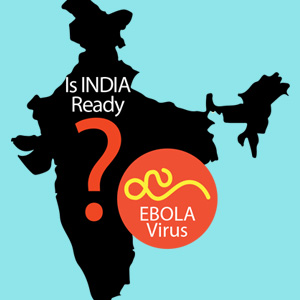
Is India prepared for Ebola?
Dense populations and weak public health systems are a fertile environment for the spread of Ebola. How will India cope with its first Ebola case?
Dr. Snigdha Vallabhaneni opines that India is fortunate “to actually have a substantial healthcare workforce and some form of public health system.” She continues, “However, I think two big challenges India will face if Ebola were to enter India are (1) the population density is very high—so transmission will occur at an unprecedented rate in this setting, and (2) there is no culture of standard infection control practices among healthcare workers in India because it is not part of their medical training. It will be very difficult to change the culture and practice of medicine to include infection control practices. This needs to be done anyway in India, Ebola or not.”
Dr. Carlos Del Rio, Chair of the Department of Global Health at the Rollins School of Public Health, Emory University, comments, “The major challenges for India would be to identify a potential traveler from an Ebola-affected country who could then present to a hospital sick. This is no different than what happened in Dallas. Once the patient is identified, India should be able to care for the individual. However, population density and poor sanitation in India will be challenging and make transmission and secondary cases more likely to occur. Training is also a challenge, not only in identifying patients but in managing them once identified.”
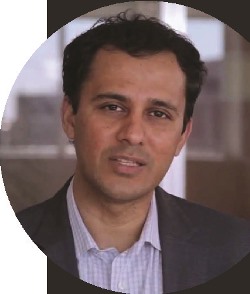
Prof. Ramanan Laxminarayan (left) of the Public Health Foundation of India and the University of Washington agrees, but suggests that the country is indeed prepared: “A new Ebola case is likely to show up in one of the metros, which all have facilities for isolation. Given that this disease is relatively easy to identify because of the speed with which it kills, and the fact that it is not very transmissible, the public health infrastructure will respond.” Both Dr. Rio and Prof. Laxminarayan point to the success of Nigeria and Senegal in containing and vanquishing Ebola as an example for India to emulate.
The Indian government seems to be proactively engaged in the response, issuing new regulations for screening travelers at immigration checkpoints and developing an Ebola preparedness protocol. The National Center for Disease Control in India has issued multiple guidelines on topics ranging from managing waste to clinical case management of Ebola. Among Indian states, public health infrastructure varies dramatically, but all state governments have apparently identified referral hospitals with isolation wards for treatment.
Funding the fight against Ebola: Donating opportunities
DOCTORS WITHOUT BORDERS:
Doctors Without Borders (Médecins Sans Frontières, MSF), an international Non-Governmental Organization, has been responding to the Ebola crisis in Guinea, Sierra Leone, Liberia, and Mali since March 2014. Its large contingent of international and local staff operate six Ebola case management centers and two transit centers. Among 3,800 patients treated for Ebola, nearly 1,600 have survived.
Donations to MSF can be made here: https://donate.doctorswithoutborders.org/onetime.cfm
CDC FOUNDATION:
The CDC Foundation supports the work of the CDC through public-private partnerships. Ever since the
CDC’s response began in July 2014, the Foundation has mobilized donor support for supplies such as personal protective equipment, infection control tools, ready-to-eat meals, generators, and vehicles for use on the ground in West Africa.
Learn more about the CDC Foundation here: http://www.cdcfoundation.org/ebola-outbreak
Enjoyed reading Khabar magazine? Subscribe to Khabar and get a full digital copy of this Indian-American community magazine.
blog comments powered by Disqus










